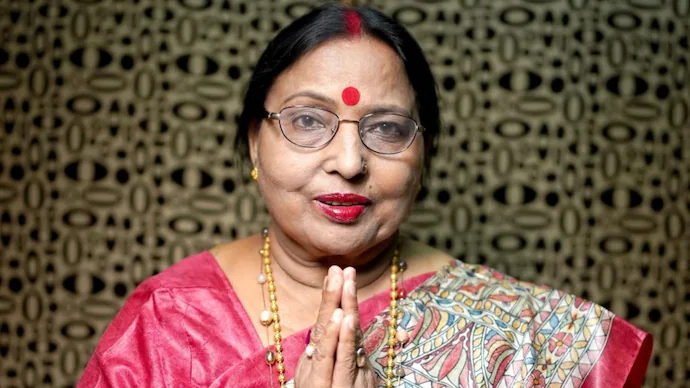Reckoning with Sharda Sinha’s demise is accepting the loss of a cultural icon. We remember her as a tune to our memories and the soul of Bihari folk music.
The “Kokila of Bihar” (Nightingale of Bihar) has rested, she passed away on November 5th at age 72 after succumbing to multiple myeloma. Sharda Sinha is synonymous with Chhath songs that extend beyond the geographical region of Bihar to states like Jharkhand, Uttar Pradesh, and the diaspora communities.
While an introduction to Sinha might begin with her mandatory Chhath songs, one eventually discovers the vast repertoire that her ripe, melodious voice covers. From covering genres of wedding songs, work songs, lullabies, Bollywood folk fusion, and devotional songs, to keeping intact the essence of dialects and languages of Maithili, Bhojpuri and Magahi, Sharda Sinha kept a commitment to maintaining the sanctity of culture and folk songs.
Regional identities often get neglected in the larger trend of fashionable pop music, and Bihar’s reputation for such an occurrence is infamously known. Degrading, double-meaning songs disallow any other representations to come to the fore. However, defying this trend, Sharda Sinha crafted a niche for herself and also allowed listeners to indulge in songs closer to home and hearts.
Arpita Tiwari, a student living in Delhi shared,
“My playlists are full of Sharda Sinha’s collections. Being part of a later generation, I did not naturally connect to the language or the culture. But the celebration of Chhath introduced me to Sharda Sinha and it overwhelmed me; her voice is different—it feels familiar and closer. You say Chhath or Vivah (marriage) songs, I hear Sharda Sinha.”
The image of Sharda forms in a quintessential way which is very important to memory. She is a big-eyed saree connoisseur, with a fierce red lip, paan-tainted teeth, and a big bold red bindi, all of which compliment her hoarse and mellow voice. This image fits perfectly the imagination of who you would think sings these songs that evoke deep emotions. She is the grandmother who contributes as an icon fashionably. Sinha drapes traditional Indian sarees that reflect the heritage and culture of Bihar. She often wore Tussar or Bhagalpuri silk along with Madhubani-printed sarees. Through these saree choices, Sharda Sinha honours the traditional textiles and artistry of Bihar, often combining them with regional jewellery for a complete, authentic look; she lived as an artist true to the culture and state embodying it to the extent of her personhood.
The beauty of Sharda Sinha’s personal life is also immense. She passed away on the first day of the Chhath festival, nahai khai, which basically kickstarts the longer celebrations. In her final days, Sinha recorded a poignant rendition titled Dukhwa Mitayin Chhathi Maiya, which was released on November 4. This song touched many hearts, especially as she performed it from her hospital bed, symbolizing her enduring dedication to her art and her connection to the Chhath Puja. Additionally, her passing followed the recent loss of her husband, adding a layer of personal sorrow to her final days.
Sharda Sinha’s contribution to the Bihari folk music is profound and lasting. Her iconography as the ambassador of a culture would
Read also: Stan Culture in Parasocial Relationships
Featured image credit: India Today
Bhavana Bhaskar

